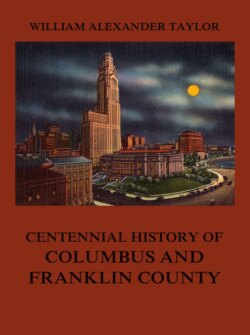Читать книгу Centennial History of Columbus and Franklin County - William Alexander Taylor - Страница 13
Оглавление
First a City.
Columbus was incorporated as a city by the act of February, 1834, and entered upon a vigorous growth and began to expand its boundaries in all directions, as well as to take on the air and appearance of solidity.
The First Theater.
In the fall of 1835 the first public play house or theater was opened. It was a large frame building and was erected on the west side of High street, between Broad and Gay, and w:as opened "by a corps of dramatic performers under the management of Messrs. Dean & McKinney," says the original chronicler.
The First Balloon Ascension.
The first balloon ascension to be witnessed at Columbus was made on the 4th of July, 1842, from the state house grounds, in the presence of a great concourse of people, gathered from a radius of thirty or forty miles, who came on horseback, in vehicles and on foot. A Mr. Clayton of Cincinnati was the aeronaut.
The First State Bank Law.
In February, 1845, what was known as the state banking law was passed by the legislature, and three banks were organized under it in the city during that year.
The First Railway Passenger Train.
The first railway passenger train entered Columbus, coming in over what was then called the Columbus & Xenia Railroad, now a part of the Panhandle System of the Pennsylvania Railway Company. It arrived on the 28th of February, 1850.
The First Museum.
Mr. William T. Martin, writing of this interesting event, says: "In July, 1851, Captain Walcutt first opened his Museum in Columbus. It then consisted of only six or seven wax figures and a few paintings. It for a time attracted as much attention and patronage as could be expected from so small a collection.
He has been since then constantly adding to it, until it now comprises over twenty good wax figures, two or three hundred specimens of beasts, birds, fossils and other curiosities and about one hundred fine oil paintings, presenting quite a respectable collection. But those of our citizens who saw it or heard of it in its infancy are not aware of its improvements and do not seem to fully appreciate it."
With 1858-1860 the "firsts" of the ancient era and regime ceased and determined, and the present forms are but the outgrowth and improvements upon those which have gone before, and in none more conspicuously than those forms appertaining to transportation, trade and travel, which appeared in its original forms in the Columbus & Xenia, Cleveland, Columbus & Cincinnati and the Ohio Central Railways of over fifty years ago.
The present great system, more elaborately presented elsewhere, including the electric street railways, evolving from the earlier tramways or horse cars, and the great web of traction and interurban lines, is but the advanced growth from the earlier forms, some of them remoter than the middle of the nineteenth century.
Instead of one steam railroad alone, as in 1850, bringing annually from eight thousand to twelve thousand visitors into the city, it now has eighteen steam roads in operation, and others in contemplation for the near future, with an average of one hundred and fifty passenger trains entering and leaving daily, and in touch with all the trunk lines more than three million two hundred and fifty thousand visitors enter the city annually.
Ten electric lines in operation, radiating in every direction, bring in and carry out more passengers daily than arrive and depart over the steam roads, so that the passengers in and out annually by both systems reach eight million or ten million.
